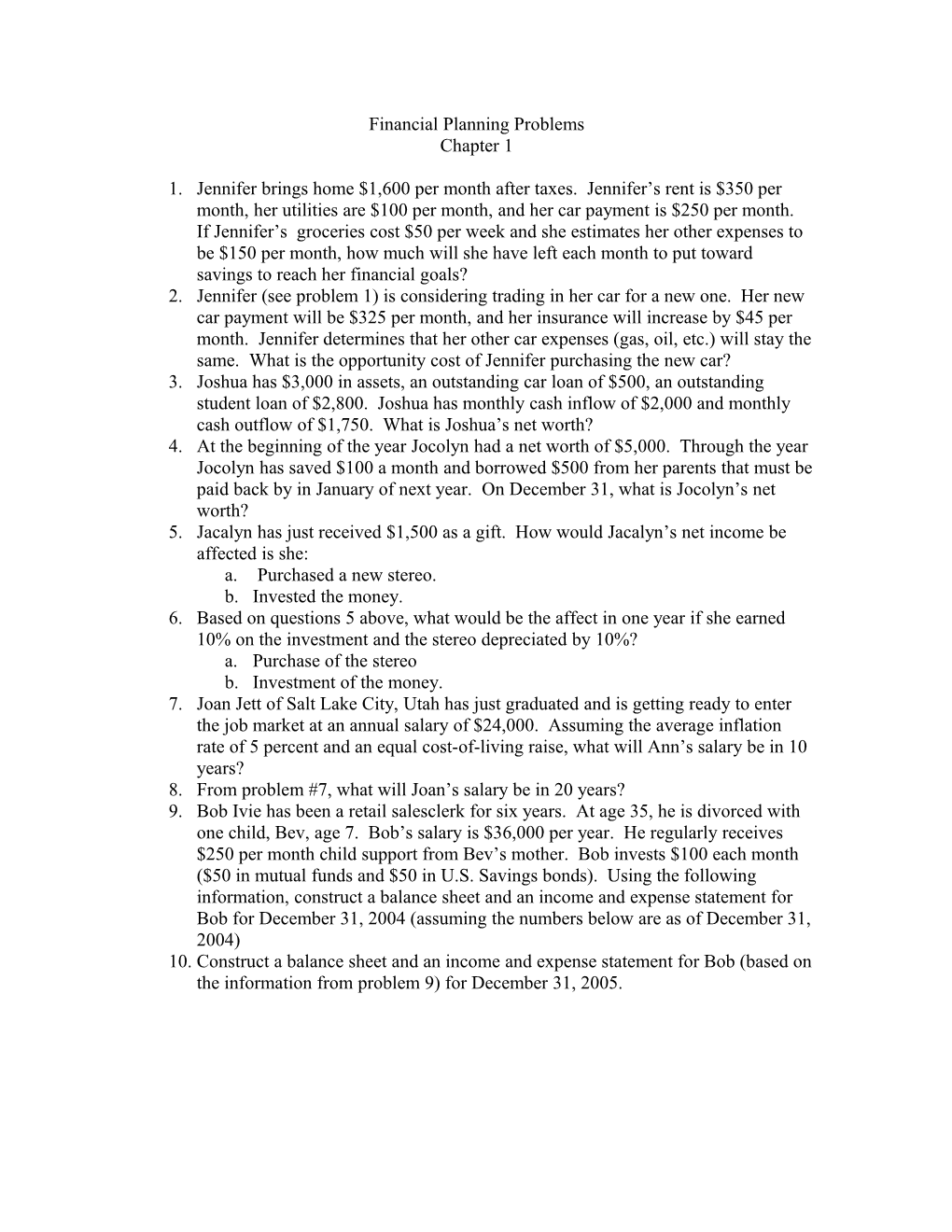Financial Planning Problems
Chapter 1
- Jennifer brings home $1,600 per month after taxes. Jennifer’s rent is $350 per month, her utilities are $100 per month, and her car payment is $250 per month. If Jennifer’s groceries cost $50 per week and she estimates her other expenses to be $150 per month, how much will she have left each month to put toward savings to reach her financial goals?
- Jennifer (see problem 1) is considering trading in her car for a new one. Her new car payment will be $325 per month, and her insurance will increase by $45 per month. Jennifer determines that her other car expenses (gas, oil, etc.) will stay the same. What is the opportunity cost of Jennifer purchasing the new car?
- Joshua has $3,000 in assets, an outstanding car loan of $500, an outstanding student loan of $2,800. Joshua has monthly cash inflow of $2,000 and monthly cash outflow of $1,750. What is Joshua’s net worth?
- At the beginning of the year Jocolyn had a net worth of $5,000. Through the year Jocolyn has saved $100 a month and borrowed $500 from her parents that must be paid back by in January of next year. On December 31, what is Jocolyn’s net worth?
- Jacalyn has just received $1,500 as a gift. How would Jacalyn’s net income be affected is she:
- Purchased a new stereo.
- Invested the money.
- Based on questions 5 above, what would be the affect in one year if she earned 10% on the investment and the stereo depreciated by 10%?
- Purchase of the stereo
- Investment of the money.
- Joan Jett of Salt Lake City, Utah has just graduated and is getting ready to enter the job market at an annual salary of $24,000. Assuming the average inflation rate of 5 percent and an equal cost-of-living raise, what will Ann’s salary be in 10 years?
- From problem #7, what will Joan’s salary be in 20 years?
- Bob Ivie has been a retail salesclerk for six years. At age 35, he is divorced with one child, Bev, age 7. Bob’s salary is $36,000 per year. He regularly receives $250 per month child support from Bev’s mother. Bob invests $100 each month ($50 in mutual funds and $50 in U.S. Savings bonds). Using the following information, construct a balance sheet and an income and expense statement for Bob for December 31, 2004 (assuming the numbers below are as of December 31, 2004)
- Construct a balance sheet and an income and expense statement for Bob (based on the information from problem 9) for December 31, 2005.
ASSETS / Amount
Vested Pension Plan / $3,000
Money market account / 5,000
Mutual fund / 4,000
Checking account / 1,000
Personal property / 5,000
Automobile / 3,000
U.S. Savings bonds / 3,000
LIABILITIES / Outstanding
Balance
Dental bill (pays $25 per month) / $450
Visa (pays $100 per month) / 1,500
Student loan (pays $100 per month) / 7,500
ANNUAL EXPENSES(pays monthly) / Amount
Auto insurance / $780
Rent / 9,096
Utilities / 1,200
Phone / 684
